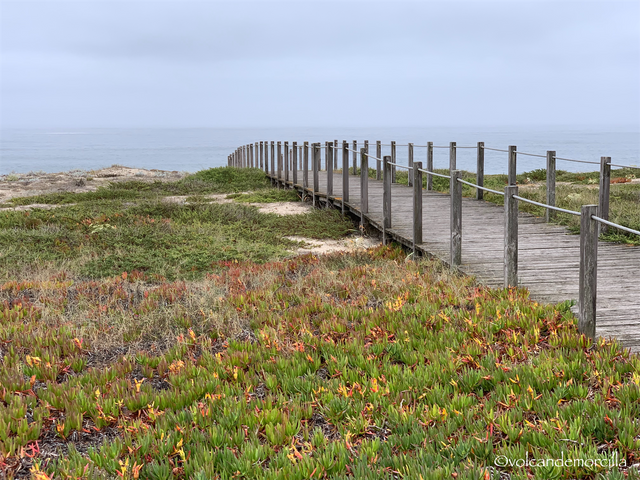
Salimos de Póvoa de Varzim con el objetivo de llegar a Fão y comer allí unas costillas a la brasa en Tio Pepe. Aquí las llaman “costelinhas” y tienen fama.
Como ayer, el tiempo está nublado pero, afortunadamente, no hay la niebla de ayer.
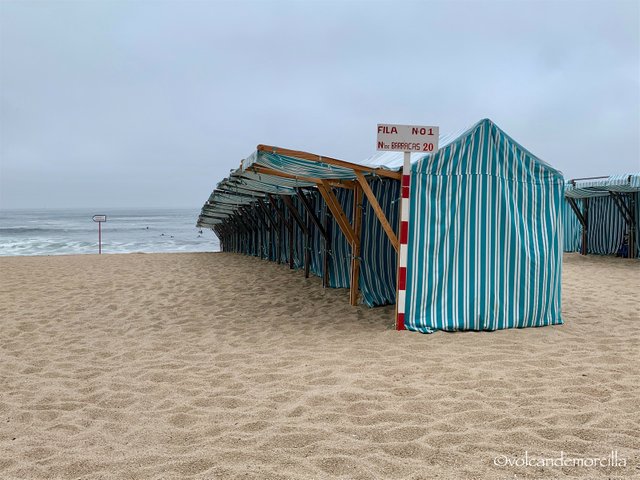
Póvoa es una ciudad turística con una gran playa de arena blanca y fina.
En la playa, hay muchas filas de casetas que se alquilan porque suele haber aire y así la gente se protege. Dentro de las casetas se estará seguramente más cómodo.
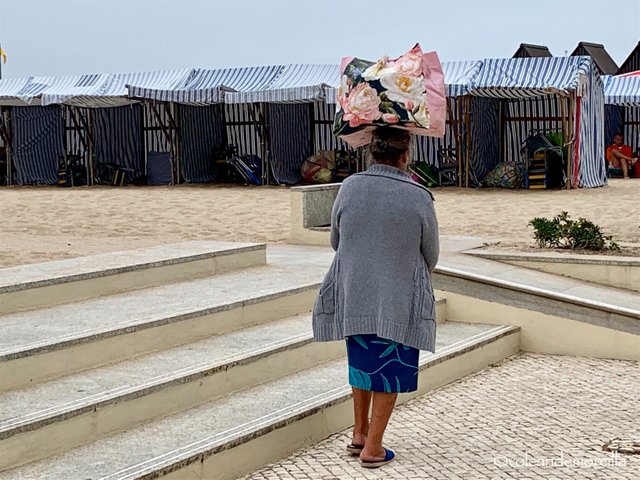
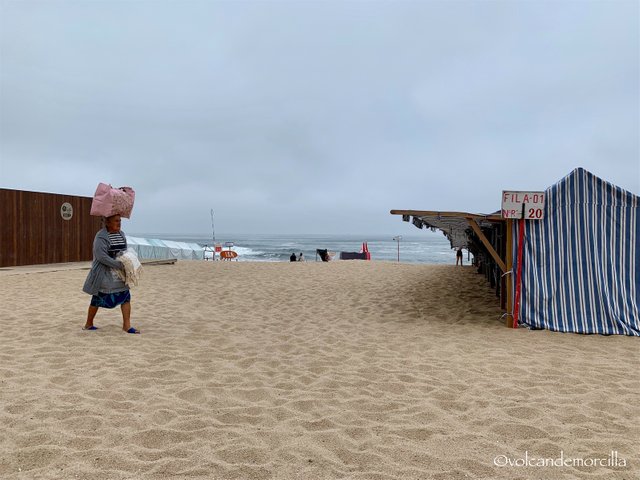
Entre las filas de caseras, hay una señora que vende paños y porta una gran bolsa en la cabeza. Como hacían aquellos individuos antes, ella carga el peso en la cabeza. En Canarias, antes había muchas mujeres que sabían caminar así. Me asombra la naturalidad con la que esta señora camina por la arena.
El paseo marítimo es nuestra puerta de salida. Hay un monumento en la plaza central que conmemora una terrible tragedia en la que se ahogaron 105 marineros a pocos metros de distancia. Gracias a algunos héroes, no hubo más víctimas, puesto que algunos salieron al rescate de mas de mil que estaban pescando merluza.
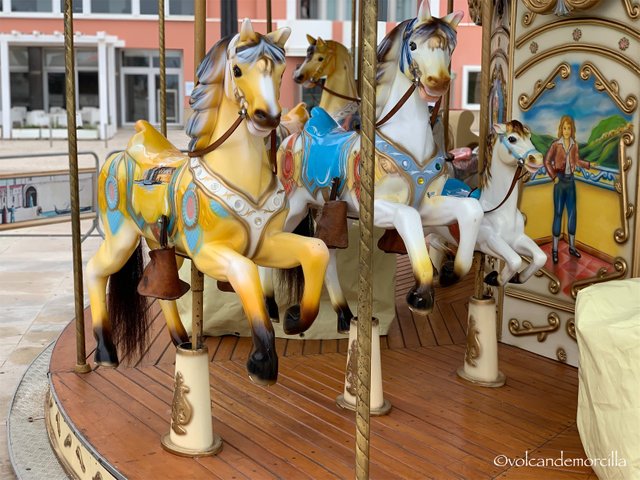
También en la plaza central hay un carrusel de caballitos. Recuerdo que me gustaba de pequeño montar en estos y saludar a mus padres cuando pasaba cerca de ellos.
En Póvoa de Varzim tienen una forma de escritura especial que hacen con segmentos rectos de cuerda. Al parecer, esta forma de escribir procede de los vikingos y con estos símbolos se identificaban las diversas familias del lugar. Estos símbolos se ven con mucha frecuencia por toda Póvoa y lo conservan con orgullo.
Otra particularidad de Póvoa es que aquí está permitido el juego y por eso hay un casino.
Mañana es la fiesta de Santiago Apóstol es el día grande de toda la peregrinación Xacobea.
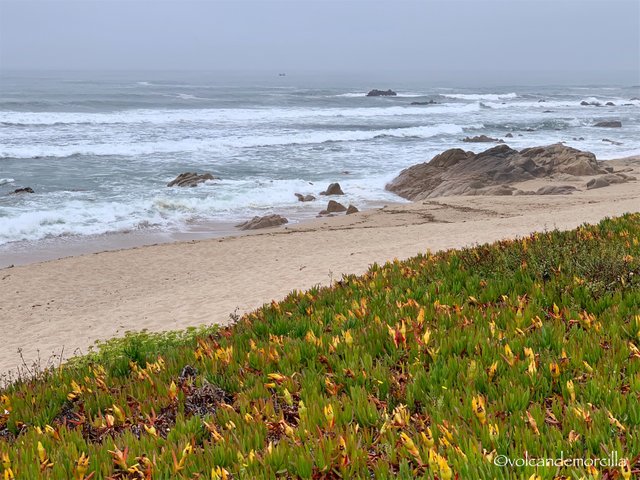
Mañana se prevé lluvia, esperemos que no sea importante.
En muchos sitios hemos visto bibliotecas de playa. Son ludotecas bien montadas con muchos libros en estanterías y además hay mesitas y sillas cómodas para poder leer en la terraza. Me parece una idea buenísima.
En la orilla hay un montón de espuma blanca. Probablemente será porque hay mar de fondo. No será debido a contaminación porque en esta zona hay muchas algas y estas son muy vulnerables a la polución de los emisarios.
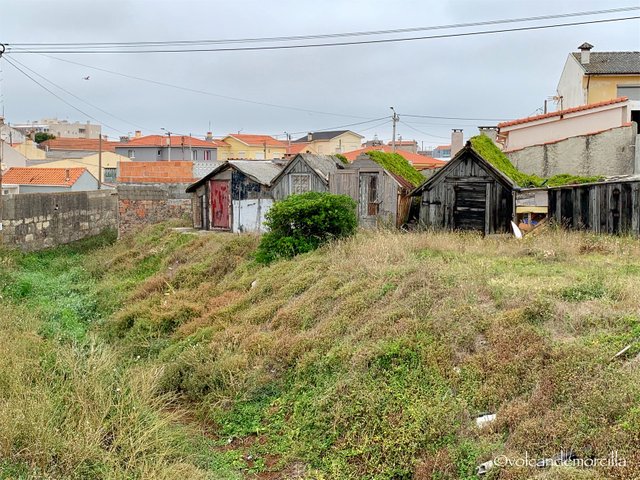
Poco a poco, nos vamos separándonos de la gran población y vamos entrando en terreno más rural.
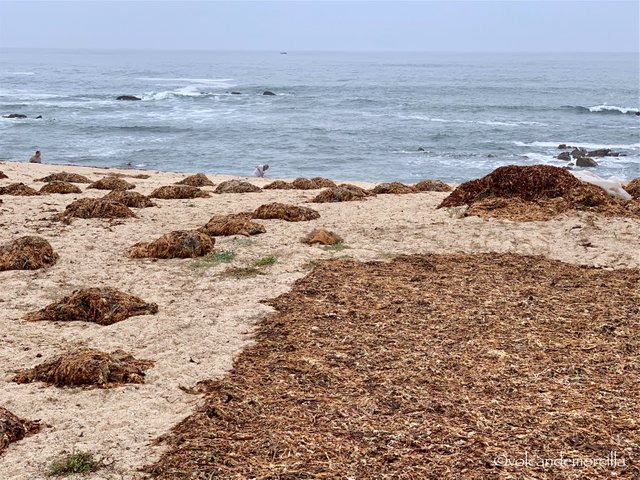
Observo algo que nunca había visto y es el aprovechamiento de las algas. Hay partes donde han acumulado las algas. Primero las extienden en una capa delgada para que se sequen y luego las agrupan. Al final consiguen prismas de algas que cubren con un plástico.
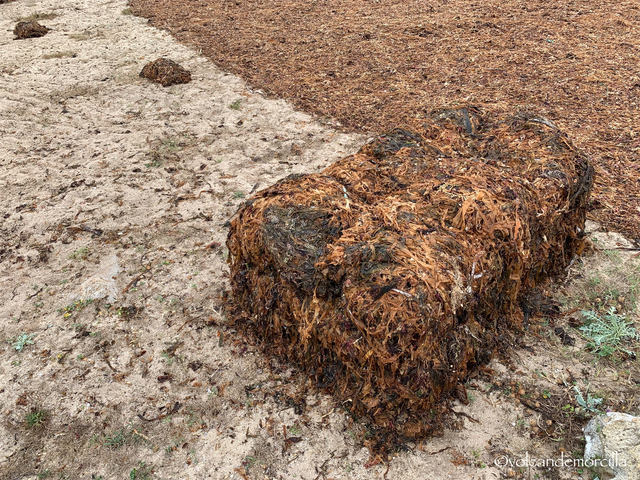
Creo que es el mismo alga roja que se ve en Cantabria. Con ella se produce el agar-agar que se utiliza en la alimentación. También las algas sirven como abono y para la calefacción.
Recogen las algas en secaderos. Las extienden en una superficie y cuando están secas las agrupan en pequeños montículos.
Proseguimos junto a la costa y vamos entrando en la zona mas rural y pobre. Observo cabras y gallos, así como las algas empaquetadas.
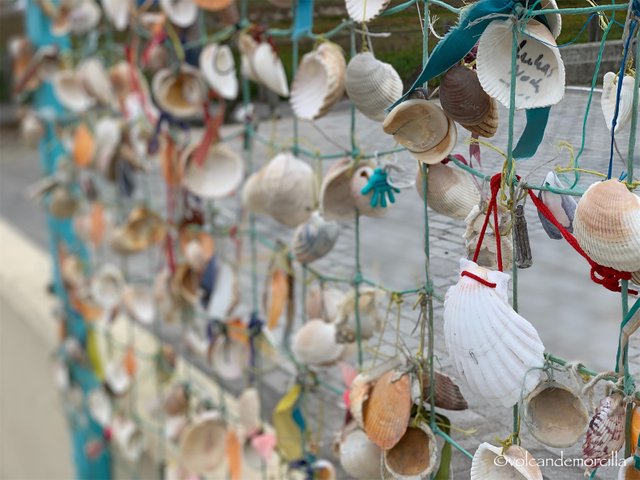
El pueblo ha crecido protegido tras una alta dunas que le separa del litoral marino y de su brisa.
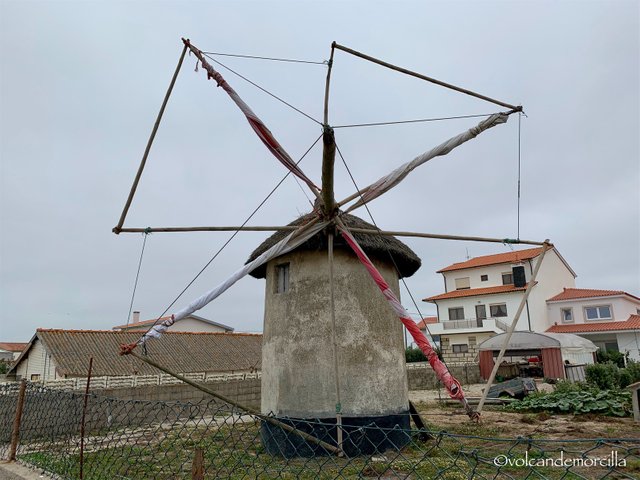
En esta zona persisten los restos de antiguos molinos. Seguramente el viento es lo normal en esta zona. De hecho, en el mar hay un importante parque de energía eólica.
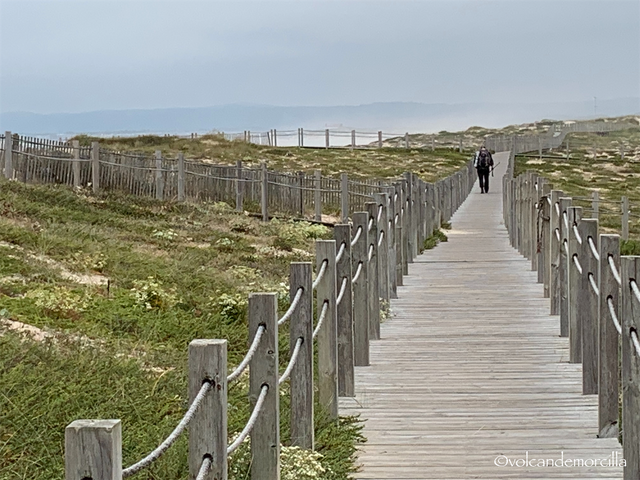
Al llegar a un campo de golf nos vemos obligados a desviamos definitivamente de la playa y comenzamos a caminar por carreteras locales. Llevamos delante un grupo de tres peregrinos que nos sirven de guías. También nos sobrepasa un peregrino de marcada edad que camina al trote y luego encontramos en la iglesia de San Miguel.
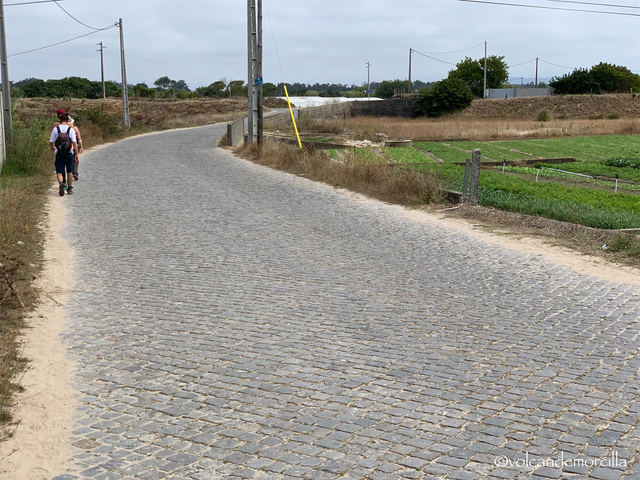
Por la carretera resulta incómodo circular porque pasan coches en ambas direcciones. No hay arcén. Debemos caminar en fila, por el margen izquierdo y tener cuidado pues los coches pasan deprisa.
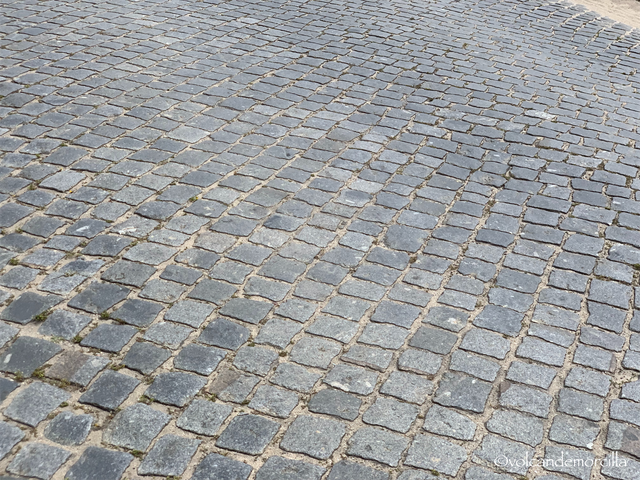
El pavimento es de pavé que a alguno de nosotros le hace daño en la planta del pie. A mi, afortunadamente no me molesta. Este recorrido, poco a poco nos va haciendo mella.
Por otro lado, es agradable caminar por esta zona rural porque es mas variada y entretenida que las tarimas.
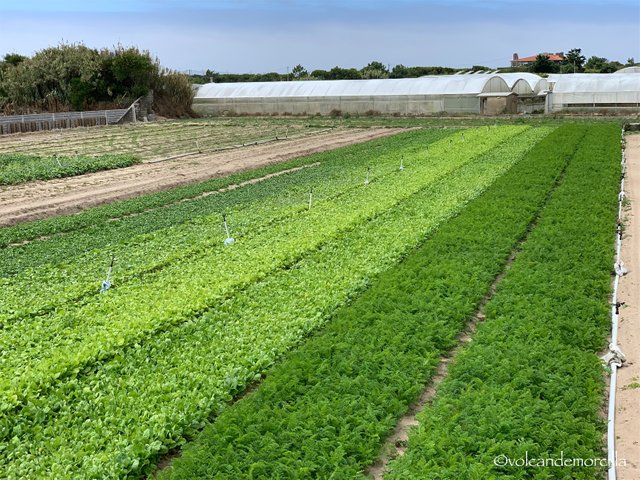
Estamos viendo cultivos de cebollas, acelgas, ajos, lechugas, etc.
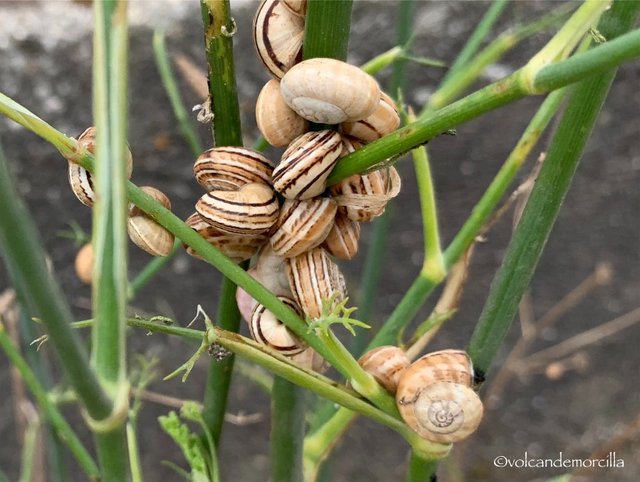
Hay muchos caracoles pequeños. Está plagadísimo.
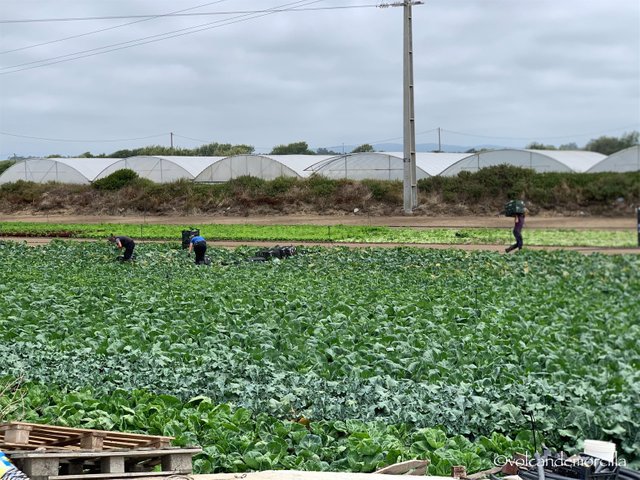
Esta zona es muy agrícola y me sorprende porque el terreno es arenoso.
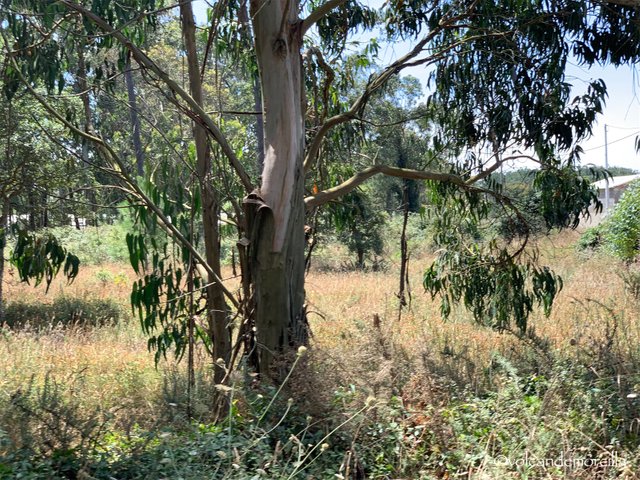
Entramos en algunas zonas de sombra donde observamos por primera vez a los eucaliptos y los pinos que serán mucho más abundantes cuando entremos en Galicia.
Vuelve la Música del Camino con el cantar de los pájaros alrededor.
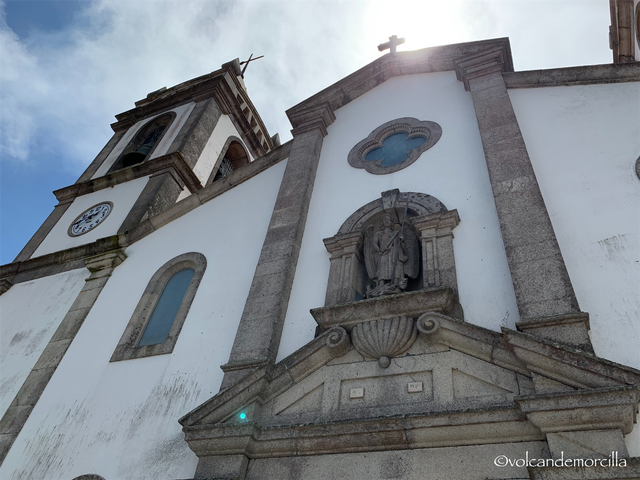
Llegamos a la iglesia de San Miguel en Apúlia. El cielo se ha despejado mucho y el sol empieza a apretar.
Hacemos una parada para visitar la iglesia y recobrar fuerzas para el último esfuerzo que queda para llegar a Fão.
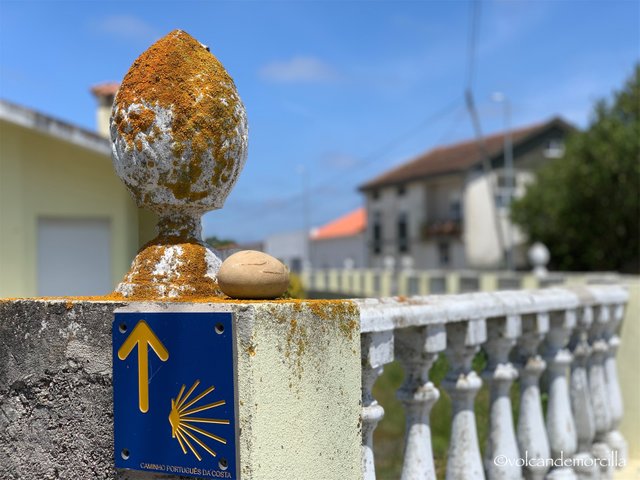
Ha sido una etapa variada. Hemos pasado por playas y por huertas pero nos ha matado caminar por estas carreteras de pavé en el último tramo.
Mañana nos espera una etapa por el interior. Esperemos que no se cumplan las previsiones de lluvia. Hasta entonces...
Bom Caminho!
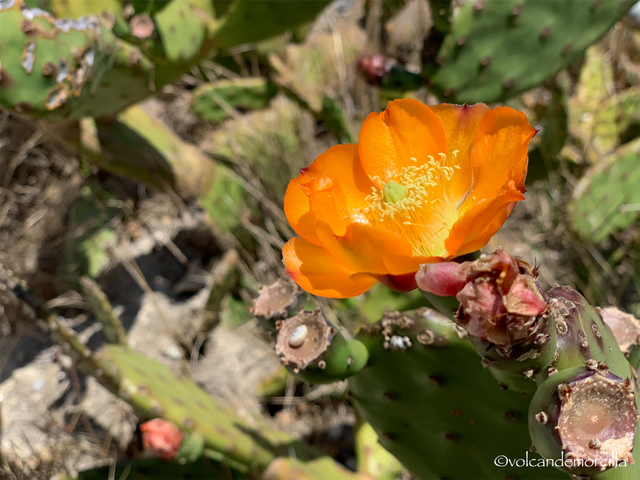
Walking between beaches and orchards
We left Póvoa de Varzim with the aim of reaching Fão and eating some grilled ribs in Tio Pepe. Here they are called "costolinhas" and are famous.
Like yesterday, the weather is cloudy but, fortunately, there is no fog from yesterday.
Póvoa is a tourist city with a large beach of fine white sand.
On the beach there are many rows of booths that rent because there is usually air and so people protect themselves. Inside the booths you will be more comfortable.
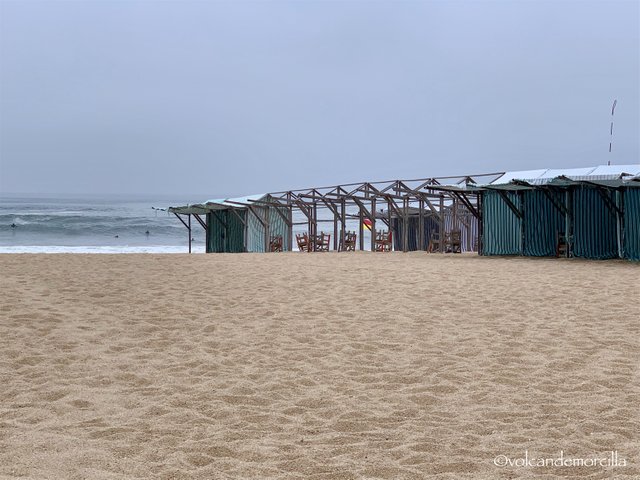
Among the rows of landlords there is a lady who sells cloths and carries a large bag on her head. As those individuals did before she carries the weight on the head. In the Canary Islands there were many who knew how to walk like this. I am amazed at the naturalness with which this lady walks through the sand.
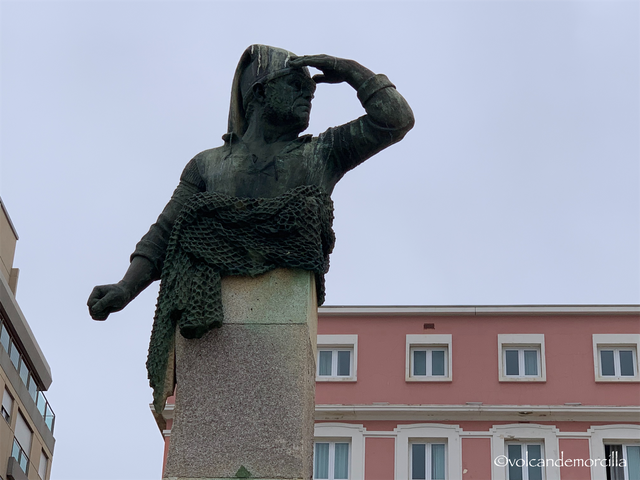
The seafront is our exit door. There is a monument in the central square that commemorates a terrible tragedy in which hundreds of sailors drowned a few meters away.
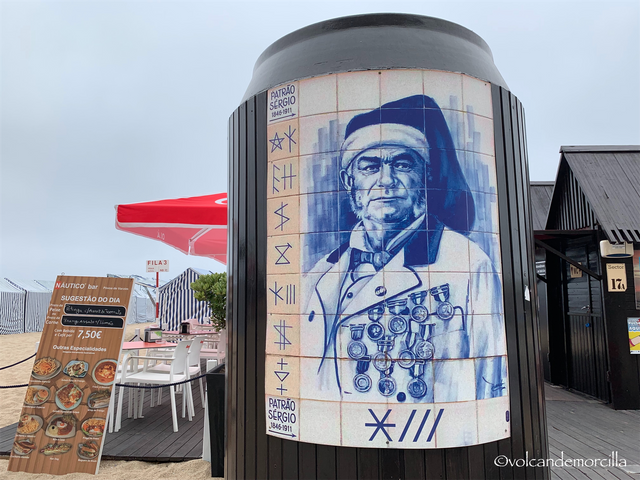
Also in the central square there is a carousel of little horses. I remember that I liked to ride in these and greet mus parents when I passed by them.
In Póvoa de Varzim they have a special writing form that they do with straight segments of rope. Apparently, this way of writing comes from the Vikings and with these symbols the different families of the place were identified. These symbols are seen very frequently throughout Póvoa and preserve it with pride.
Another peculiarity of Póvoa is that the game is allowed here and that is why there is a casino.
Tomorrow is the festival of Santiago Apostle is the big day of the entire Xacobea pilgrimage.
Tomorrow rain is expected, hopefully not important.
In many places we have seen beach libraries. They are well-assembled toy libraries with many books on shelves and there are also comfortable tables and chairs to read on the terrace. I think it's a great idea.
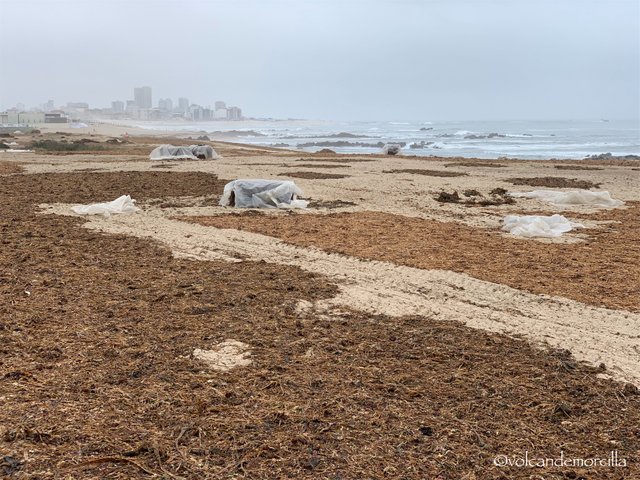
On the shore there is a lot of white foam. It will probably be because there is a deep sea. It will not be due to pollution because in this area there are many algae and these are very vulnerable to the pollution of emissaries.
Little by little, we are separating ourselves from the large population and we are entering more rural land.
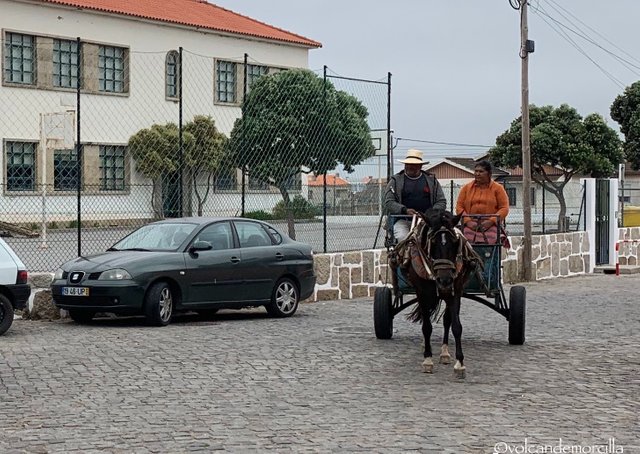
I observe something I had never seen and it is the use of algae. There are parts where algae have accumulated. First they spread them in a thin layer to dry and then group them together. In the end they get prisms of seaweed that cover with a plastic.
I think it's the same red algae that is seen in Cantabria. With it the agar-agar that is used in the feeding is produced. Algae also serve as fertilizer and for heating.
They collect the seaweed in dryers. They extend them on a surface and when they are dry they are grouped into small mounds.
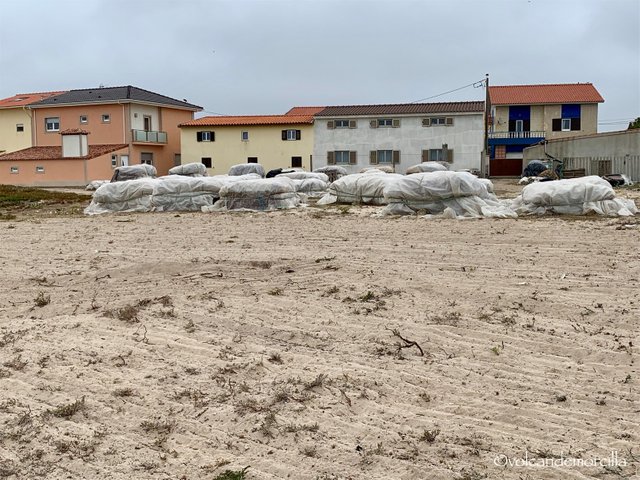
We continue along the coast and we are entering the most rural and poor area. I observe goats and roosters, as well as packaged seaweed.
The town has grown protected after a high dune that separates it from the sea coast and its breeze.
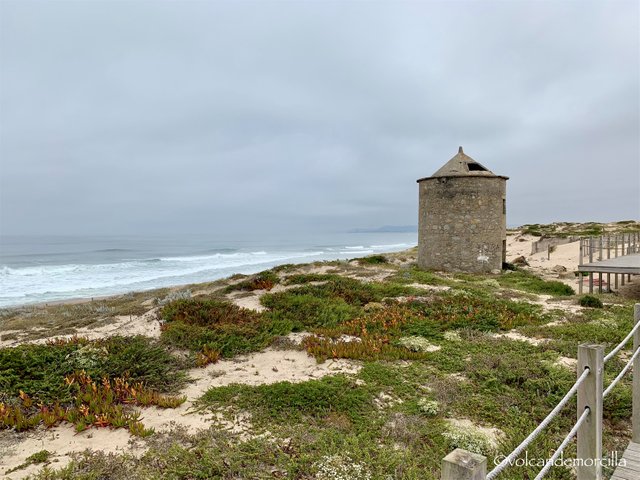
In this area the remains of old mills persist. Surely the wind is normal in this area. In fact, in the sea there is an important wind energy park.
Upon arriving at a golf course we are forced to deflect definitively from the beach and start walking on local roads. We lead a group of three pilgrims who serve as guides. We are also surpassed by a pilgrim of marked age who walks trotting and then we meet in the church of San Miguel.
On the road it is uncomfortable to drive because cars pass in both directions. There is no shoulder. We must walk in line, on the left bank and be careful because cars pass quickly.
The pavement is made of pavé that hurts some of us on the sole of the foot. Fortunately, it doesn't bother me. This tour, little by little, is making a dent.
On the other hand, it is nice to walk through this rural area because it is more varied and entertaining than the platforms.
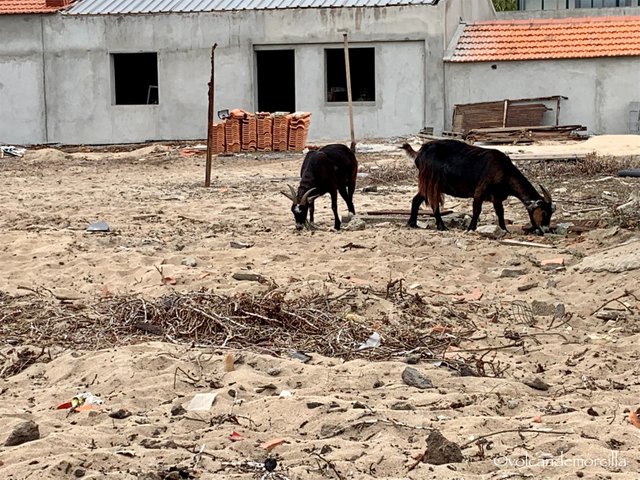
We are seeing crops of onions, chard, garlic, lettuce, etc.
There are many small snails. It is very plagued.
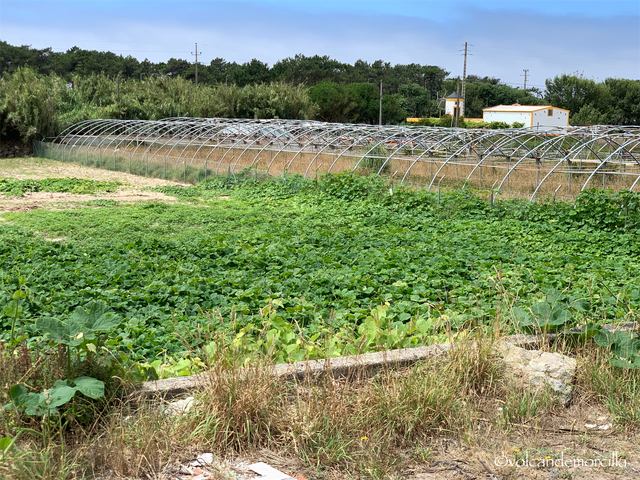
This area is very agricultural and it surprises me because the terrain is sandy.
We enter some shady areas where we observe eucalyptus and pine trees for the first time, which will be much more abundant when we enter Galicia.
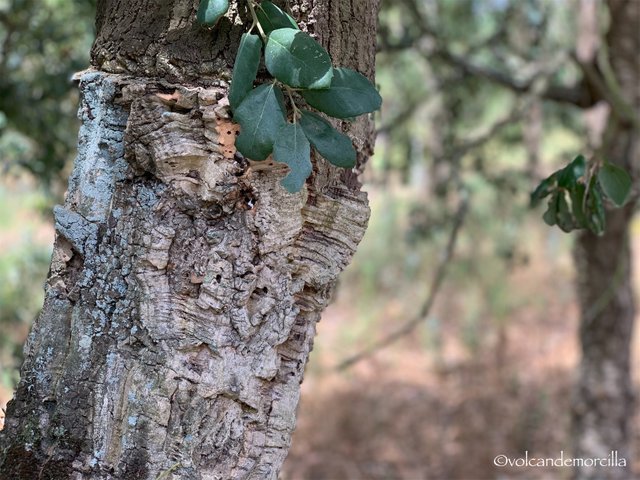
The Music of the Road returns with the singing of the birds around.
We arrived at the church of San Miguel in Apúlia. The sky has cleared a lot and the sun begins to tighten.
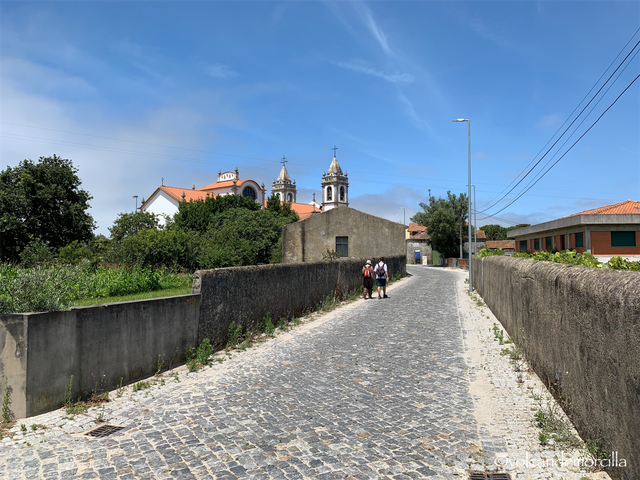
We make a stop to visit the church and regain strength for the last effort that remains to reach Fão.
It has been a varied stage. We have passed through beaches and orchards but it has killed us to walk along these pavé roads in the last section.
Tomorrow we expect a stage inside. Hopefully the rain forecasts are not met. Until then...
Bom Caminho!
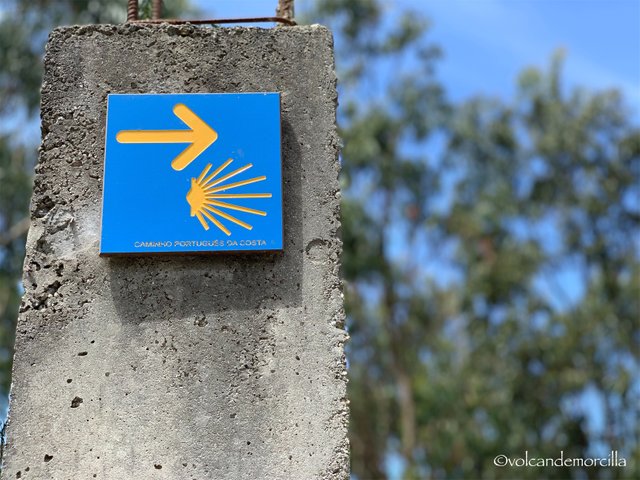

Cómo lo hago
Hice las fotografías con mi iPhone X. Para la edición utilicé la aplicación Snapseed y para la firma digital usé la App Watermark.
Los dibujos los hice en el iPad con el programa Sketches.
For the photography I use my iPhone X. For edition I use the Snapseed application and for the digital signature the Watermark app.
Everything I did on my mobile phone, I did not use the computer at all.
For the drawings, I use the Sketches program and paint them on the tablet.
Si quieres ver como lo hago, visualiza estos tres enlaces de publicaciones previas.
If you want to see how I do it, visualize these three links from previous publications.

Las fotos son mías y originales. También, soy el autor del dibujo separador.
¡Espero tus comentarios!
The photos are originals and mine. Also, I am the author of the separator drawing.
I await your comments.
¡Bom Caminho!
Me fui a Povoa de Varzim con estas imagenes. Buen articulo, espero seguir viendo imagenes como estas.
Downvoting a post can decrease pending rewards and make it less visible. Common reasons:
Submit
Muchas Gracias
Escribo en pesetas para crear mayor sensación de proximidad y compañía. Gracias por acompañarme.
Un saludo 🤗
Posted using Partiko iOS
Downvoting a post can decrease pending rewards and make it less visible. Common reasons:
Submit
Muy buen metodo... bendiciones
Downvoting a post can decrease pending rewards and make it less visible. Common reasons:
Submit
Downvoting a post can decrease pending rewards and make it less visible. Common reasons:
Submit
Muchas Gracias amigos 😊
Downvoting a post can decrease pending rewards and make it less visible. Common reasons:
Submit
Que curioso lo de las algas! Tuviste un día variado nublado. Sol...
Espero no os mojeis mucho hoy que tengáis buena caminata y que aprovechen esas costillas!
Downvoting a post can decrease pending rewards and make it less visible. Common reasons:
Submit
Las costillas fueron lo mejor que hemos comido.
De rechupete, jejejej
Te muestro
Downvoting a post can decrease pending rewards and make it less visible. Common reasons:
Submit
Qué bonito y bien contado, por lo que veo ¿ya comenzaron el Camino?
¡Buen camino!
Downvoting a post can decrease pending rewards and make it less visible. Common reasons:
Submit
Ya estamos metidos en harina con muchos kilómetros en la mochila. Hoy creo que fue la sexta etapa. Todo fantástico!
Un abrazo 🤗
Posted using Partiko iOS
Downvoting a post can decrease pending rewards and make it less visible. Common reasons:
Submit
Es un lugar hermoso te envió un abrazo.
Downvoting a post can decrease pending rewards and make it less visible. Common reasons:
Submit
Que bueno que compartas con toda la comunidad de Steemit estos paisajes... Muestran que fue un buen camino recorrido... Saludos...
Downvoting a post can decrease pending rewards and make it less visible. Common reasons:
Submit
Estoy disfrutando mucho, no solo del Camino sino también de mi familia. Estamos ahora más unidos. El cansancio nos ha creado solidaridad y trabajo en común.
Un abrazo 🤗
Posted using Partiko iOS
Downvoting a post can decrease pending rewards and make it less visible. Common reasons:
Submit
Me gustan mucho las btácoras porque siento que camino por esas calles. Muy bueno de verdad, las fotos son excelentes
Downvoting a post can decrease pending rewards and make it less visible. Common reasons:
Submit
Muchas Gracias. Escribo en presente para crear mas la sensación de compañía. Un saludo.
Posted using Partiko iOS
Downvoting a post can decrease pending rewards and make it less visible. Common reasons:
Submit
Pues lo logras a la perfección ✌️ 😆
Downvoting a post can decrease pending rewards and make it less visible. Common reasons:
Submit
Estoy a tu lado amigo. Acompañándote. Me fascina el mar. Me gusto la idea de las bibliotecas en la playa.
No me dio tiempo de sentarme a leer estas muy apurado.
Los molinos me recuerdan a Don Quijote y a Sancho Panza,
Un abrazo.
Downvoting a post can decrease pending rewards and make it less visible. Common reasons:
Submit